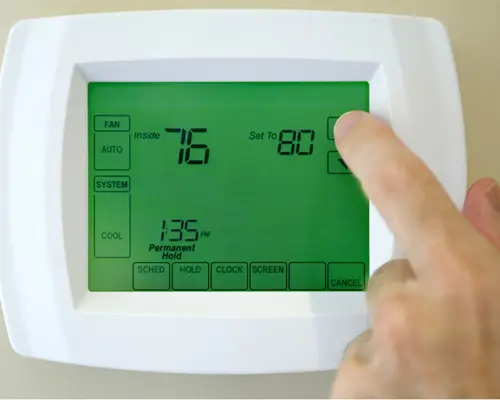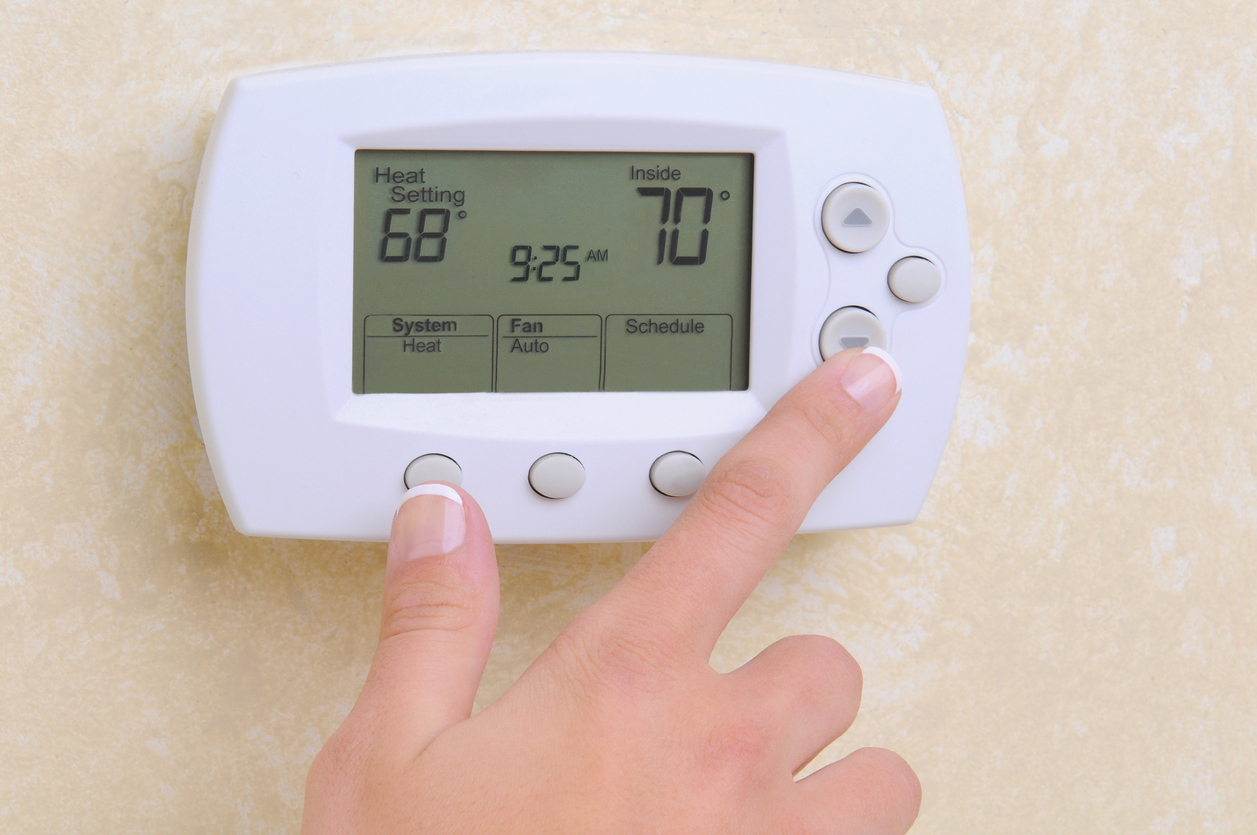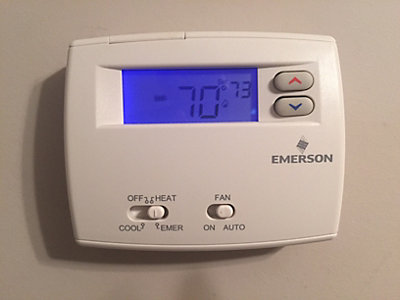Check Best Thermostat Pricing in Amazon
** As an Amazon Associate, I earn from qualifying purchases.
Wondering what temperature to set your thermostat to in winter? The answer can save money and keep your home comfortable.
Finding the right temperature is key to staying warm and managing energy bills. Winter can be harsh, and heating costs often rise. Setting your thermostat at an optimal temperature helps maintain comfort without overspending. There’s no one-size-fits-all answer; factors like home insulation and personal preference matter.
Some enjoy a toasty home, while others prefer cooler settings. Balancing comfort and cost is crucial during the cold months. This guide will help you determine the best thermostat setting for winter, considering various factors to keep you cozy and your wallet happy.

Credit: www.ars.com
Optimal Winter Thermostat Settings
Set your thermostat to 68°F (20°C) during the day for comfort and energy savings in winter. Lower it to 60-62°F (15-16°C) at night for better sleep and reduced heating costs.
When winter rolls around, setting your thermostat can feel like a balancing act between staying comfortable and managing your energy bills. Finding that sweet spot is crucial not just for your comfort but also for your wallet. Let’s dive into what the optimal winter thermostat settings should be to keep you warm without breaking the bank.Ideal Temperature Range
The ideal temperature range in winter is typically between 68°F and 72°F. This range keeps your home cozy without overworking your heating system. Many experts recommend setting your thermostat to 68°F during the day. This temperature is warm enough to be comfortable but efficient enough to keep your heating costs down. If you feel chilly at 68°F, consider wearing layers or using a blanket instead of cranking up the heat. This small adjustment can lead to significant savings over time.Day Vs. Night Settings
Your thermostat settings don’t have to stay the same all day. Adjusting your thermostat at night can make a big difference in your energy usage. At night, you can lower your thermostat by 7-10 degrees. This reduction can save you up to 10% a year on heating costs. Aim for around 60°F to 62°F while you sleep. Worried about getting too cold? Use warmer bedding or a heated blanket. This way, you stay warm and save money at the same time. Have you considered using a programmable thermostat? It can automatically adjust the temperature based on your schedule, ensuring you wake up to a warm home without needing to manually change the settings. Finding the right balance in your thermostat settings can make your winter much more enjoyable. What changes will you make to stay warm and save money this season?Energy Efficiency Tips
Adjusting your thermostat during the winter can save energy and reduce bills. Knowing the right settings and tips for energy efficiency is key.
Reducing Energy Consumption
Lowering your thermostat by 7-10 degrees for 8 hours a day can save you up to 10% a year on heating. At night or when you’re not home, set it lower. Wear warm clothes and use blankets to stay comfortable. Seal windows and doors to prevent heat loss. Use heavy curtains to keep the warmth inside.
Ensure your heating system is well-maintained. Clean or replace filters regularly. This helps the system run more efficiently. Consider using space heaters in occupied rooms. This allows you to lower the thermostat for the whole house.
Using Programmable Thermostats
Programmable thermostats adjust the temperature automatically based on your schedule. Set it to lower the temperature when you’re asleep or away. Program it to warm up before you wake or return home. This ensures comfort without wasting energy.
Some models offer remote control via smartphone. This allows for adjustments even when you’re not home. Learning thermostats can adapt to your habits over time. They optimize settings for maximum efficiency.
Investing in a programmable thermostat can lead to significant savings. It makes managing your home’s temperature easier and more efficient.
Balancing Comfort And Cost
Setting the thermostat to 68°F during winter can balance comfort and cost. Lowering it at night saves energy.
Balancing comfort and cost during the winter months can be tricky. You want to stay warm, but you don’t want to see a huge spike in your heating bills. Finding the right thermostat setting is crucial to achieving this balance.Finding The Sweet Spot
You don’t have to sacrifice comfort to save on heating costs. The recommended thermostat setting for winter is around 68°F (20°C) when you’re awake and at home. Lower it by a few degrees when you’re asleep or away. This small adjustment can make a big difference. Each degree you lower the thermostat can save you up to 3% on your heating bill. It might take a few days to get used to, but your body will adjust. Everyone’s comfort level is different. If 68°F feels too cold, try 70°F and see how that impacts your bills. The key is to find a balance where you’re comfortable without overburdening your wallet.Impact On Heating Bills
Heating your home accounts for a significant portion of your energy bill. Lowering the thermostat just a little can lead to substantial savings over time. Consider using a programmable thermostat. These devices can automatically adjust the temperature based on your schedule. Set it to lower the temperature while you’re at work or asleep and raise it before you wake up or return home. Another tip is to dress warmly indoors. Wearing layers and using blankets allows you to keep the thermostat at a lower setting without sacrificing comfort. Think about the long-term impact. Small changes now can lead to lower heating costs throughout the winter. Plus, you’ll be doing your part to reduce energy consumption. Have you tried adjusting your thermostat settings before? What worked for you? Share your experiences and tips in the comments below.Health Considerations
Setting the thermostat correctly in winter is important for your health. Maintaining the right temperature can help prevent health issues. It keeps your home comfortable and safe.
Preventing Dry Air
Heating your home can cause dry air. Dry air leads to dry skin, sore throats, and itchy eyes. Setting the thermostat to a moderate temperature can help. Aim for 68 to 72 degrees Fahrenheit. Use a humidifier to add moisture. This helps maintain a healthy humidity level in your home.
Maintaining Indoor Air Quality
Indoor air quality is vital during winter. Closed windows reduce fresh air circulation. This can trap pollutants inside. Regularly change air filters to improve air quality. Clean filters reduce dust and allergens. Also, avoid using strong chemicals indoors. They can worsen air quality. Good ventilation helps, so open windows when possible.
Regional Differences
Different regions require different thermostat settings in winter. In warmer areas, set it lower. Colder regions need higher settings to stay comfortable.
Setting the thermostat in winter can be tricky, especially given regional differences. What works in one area might not work in another. Understanding how your local climate impacts your heating needs is essential for comfort and efficiency.Climate And Weather Impact
The climate you live in greatly affects your thermostat settings. In colder regions, like the Midwest or Northeast, you may need to keep your home warmer. This is because the outside temperature drops significantly, making indoor heating more crucial. In contrast, if you live in milder climates, such as the southern states, you can set your thermostat lower. You might only need to adjust it slightly to maintain a comfortable indoor temperature. Think about how the weather impacts your daily routine. Would you wear a heavy coat indoors if it’s relatively mild outside?Localized Recommendations
Different areas have different standards for comfortable indoor temperatures. In colder regions, it’s common to set the thermostat between 68°F and 72°F during the day. At night, you might lower it by a few degrees to save on energy costs. In warmer areas, you might find that setting the thermostat to 65°F or lower works just fine. Your body is accustomed to a warmer climate, so slightly cooler indoor temperatures can feel refreshing. Try experimenting with settings in your own home. If you find a particular temperature comfortable, stick with it. Adjust the thermostat based on your personal needs and preferences, but keep these regional guidelines in mind. Consider how your neighbors set their thermostats. Have you ever noticed a difference when visiting friends in other regions? Use these experiences to inform your own choices. By understanding regional differences, you can make more informed decisions about your winter thermostat settings. This ensures your home remains comfortable and your energy bills stay manageable.
Credit: www.angi.com
Tips For Families
Winter can be a tricky season for families trying to find the perfect thermostat setting. The right temperature can vary depending on the age and needs of each family member. Here are some practical tips to help you keep everyone comfortable during the colder months.
Settings For Kids And Seniors
Kids and seniors are often more sensitive to temperature changes. For kids, aim for a setting between 68-72°F during the day. This range ensures they stay warm without overheating.
Seniors typically prefer warmer environments. A setting of around 70-74°F during the day can keep them comfortable. At night, consider lowering the thermostat slightly to 65-68°F to promote better sleep for everyone.
Managing Different Preferences
Families often have members with different temperature preferences. Managing these differences requires a bit of compromise. One approach is to layer clothing. Encourage everyone to wear sweaters or use blankets to adjust to their comfort level.
Another solution is to use space heaters in specific rooms. This allows family members to have a warmer space without adjusting the whole house’s temperature. Just ensure these heaters are used safely to avoid any accidents.
Consider setting up a family meeting to discuss and agree on a general temperature range. This can help everyone feel heard and comfortable.
What strategies have you found effective in managing thermostat settings for your family? Share your tips in the comments below!
Smart Thermostat Advantages
Winter can be a challenging time to keep your home warm without breaking the bank. One of the most effective solutions is using a smart thermostat. These devices offer several advantages that make managing your home’s temperature more convenient and efficient. Let’s dive into some of the key benefits of smart thermostats.
Check Best Thermostat Pricing in Amazon
** As an Amazon Associate, I earn from qualifying purchases.
Remote Control Features
Imagine being able to adjust your home’s temperature without leaving your bed or even when you’re miles away. Smart thermostats allow you to do just that through your smartphone. You can increase or decrease the temperature while you’re at work, ensuring you come back to a cozy home.
Ever left for vacation and forgot to turn down the heating? With remote control features, you can easily make adjustments from anywhere. This not only saves energy but also reduces your utility bills.
Having this level of control can be particularly beneficial during unexpected weather changes. If a cold snap hits while you’re out, you can quickly warm up your home, ensuring comfort upon your return.
Learning Capabilities
Smart thermostats don’t just follow your commands; they learn from your behavior. Over time, they adapt to your schedule and preferences, automatically making adjustments for you. This means your home will always be at the right temperature without constant manual changes.
For instance, if you tend to lower the temperature before bed, the thermostat will start doing it for you. This learning capability ensures optimal comfort with minimal effort on your part. Plus, it can significantly reduce energy consumption by avoiding unnecessary heating.
Think about the convenience of never having to worry about adjusting the thermostat again. The learning capabilities of smart thermostats make this possible, providing both comfort and efficiency.
What’s your experience with smart thermostats? Do you find their features useful in managing your home’s temperature? Share your thoughts and let’s discuss how these devices can make winter more bearable.

Credit: greensenergy.com
Common Mistakes
Setting your thermostat correctly in winter can be tricky. It’s easy to make mistakes that lead to higher bills or uncomfortable living conditions. Let’s explore some common mistakes to help you avoid them.
Avoiding Overcorrection
Overcorrecting the thermostat is a common mistake. If you come home to a cold house, you might be tempted to set the thermostat too high. This won’t heat your home faster but will lead to higher energy costs.
Instead, set the thermostat to your desired temperature and wait. Your heating system works at a constant rate. Cranking it up won’t speed things up.
Also, consider using a programmable thermostat. It can adjust the temperature automatically, ensuring your home is warm when you need it to be.
Understanding Thermostat Functions
Do you know all the functions of your thermostat? Many people don’t. Failing to understand its settings can lead to inefficient heating.
Spend some time reading the manual. Learn about different modes and settings. For example, the “auto” setting can help maintain a consistent temperature without constant adjustments.
If your thermostat has a timer, use it. Set it to lower the temperature when you’re not home and raise it before you return. This simple step can save you money and keep your home comfortable.
Have you ever checked your thermostat’s location? If it’s near a heat source, it can give inaccurate readings. Ensure it’s placed in a central location away from drafts, direct sunlight, and heat-producing appliances.
Understanding these functions can make a significant difference. You’ll have a more comfortable home and lower energy bills.
What mistakes have you made with your thermostat? How did you fix them? Share your tips in the comments!
Frequently Asked Questions
Is 72 Too High For Thermostat In Winter?
A thermostat set to 72°F in winter is comfortable for most. It balances warmth and energy efficiency. Adjust based on personal preference.
Is 72 Cold In Winter?
72 degrees is not cold in winter. It’s considered mild and comfortable for most people.
What Is The Best Thermostat Setting For Winter?
Set your thermostat to 68°F during the day for optimal comfort and energy savings in winter. Lower it at night or when away.
What Should I Set My Thermostat To During A Freeze?
Set your thermostat to 68-72°F during a freeze. This helps keep your pipes from freezing and maintains comfort.
Conclusion
Setting your thermostat correctly in winter saves energy and money. Aim for 68°F when home. Lower it when away or asleep. Use blankets and wear layers for extra warmth. Smart thermostats help you manage temperatures easily. Stay comfortable while being energy-efficient.
Follow these tips for a cozy winter season.
Check Best Thermostat Pricing in Amazon
** As an Amazon Associate, I earn from qualifying purchases.


